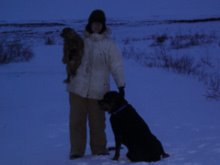.jpg)
(This picture of the afternoon rush hour on the Kuskokwim River was taken by Genevieve. I borrowed it with hopes of permission. For details of this picture, and the other adventures enjoyed by Dawson and Genevieve in the course of housesitting for Tom, sleeping with Kusko, and bringing home a new baby in the middle of winter to a house-sitted house with a notoriously cold toilet seat, please click here. For pictures of our taxi cabs, please stay tuned. We'll see if I can get one to hold still long enough for my camera to turn on.)
I have recieved several forwarded copies of the same article. Most of them come from friends in New York and Seattle that are pleased as punch about finding an article about Alaska. They are too urban, and suave and free of duct-taped patches to holler it up like I do these days. But, had they as much outdoor frolic space and duct tape as me, I'm sure they'd be doing their own muddy cartwheels of glee about finding an article that compares my tundra island to my former stomping grounds. Since they don't, I expect that they are having much fun talking about it over oysters and a crisp Pacific Northwest vino - and I thank them for all the vicarious living I derive from that image. In any event, I think their enthusiasm is Fate telling me that I need to forward it along.
Enjoy!
Small Alaska town is big on taxicabs
By RACHEL D'ORO
The Associated Press
Bethel, Alaska, has a population of 5,900, but there are 70 taxicabs ferrying riders around the community; that's one cab for every 84 people. Why? Cars have to be flown or barged in.
BETHEL, Alaska — You won't find a luxury hotel or concert hall in Bethel, and you probably can't get a decent bagel here. But this remote Alaska town has at least one advantage over New York City: It may be the nation's taxicab capital.
Situated on the tundra about 400 miles west of Anchorage, Bethel has 70 taxis for a population of just 5,900. That's one cab for every 84 people.
That's better even than New York, the ultimate cab city, where there is one hired vehicle — such as a taxi, commuter van or car — for every 149 people.
"It's most likely by far the highest ratio of taxis per residents in the United States," said Alfred LaGasse with the Taxicab, Limousine & Paratransit Association.
Why the big fleet of taxis? Bethel, which is surrounded by thousands of ponds in a delta plain, is inaccessible by road. People must fly cars in or bring them in by barge on the Kuskokwim River, which can cost thousands.
"I bought a small Ford Focus, and it cost $2,000 to fly it in," said Mark Springer, chairman of the local transportation commission. "Then of course, there's the cost of gas, almost $5 a gallon here. Cabs in Bethel are very, very convenient."
Fewer than half the adults have their own car or truck. Some families own snowmobiles, but those are good only in winter.
As a result, taxi drivers — many of them non-Alaskans, mostly Koreans and Albanians — have flocked here to fill the gap. Cabs seem to be everywhere, squeezing in passengers who pay $4 to go anywhere in the main part of town, and $6 to the airport three miles away.
Gim Jong-ihn, 72, was visiting his hometown in South Korea when he saw a TV story about the scores of cabdrivers working in Bethel. He came here two years ago to drive a taxi after retiring from asbestos-removal work in New York.
He may not have realized exactly what he was getting into: When he arrived in Anchorage, he naively asked where he could catch a Greyhound bus to Bethel.
Bethel is largely a collection of utilitarian buildings on stilts, simple homes and shacks, with water and sewer pipes built above ground because the permafrost below the surface is rock-hard.
But the town serves as a commercial hub for the vast region, with visitors from 56 largely Eskimo villages coming here to shop, see their doctor or do other errands. Visitors arrive by plane year-round, by snowmobile in winter and by boat in summer.
Often, taxi passengers do not get a cab all to themselves. As novices soon discover, drivers make constant stops and passengers pile in.
Because cabs are shared, regulars like Bethel resident Joanna Simeon know to leave plenty of time for travel.
"Newcomers think they'll just hop in a cab and go right to work, then it stops 20 times," she said.
"They get to see a lot of Bethel."


No comments:
Post a Comment